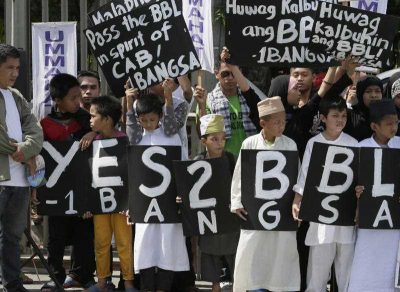Is the so-called ‘Islamic State’ (IS) militant group gaining a foothold in the Philippines? The declaration of the first IS wilayat (province) in Southeast Asia appeared possible after Filipino and Malaysian militants from previously separate jihadist groups pledged allegiance to IS in an online video released in January 2016. Recognition from IS would certainly increase the attractiveness of Mindanao to jihadists based in Southeast Asia. But there is little solid evidence of a formal relationship between Mindanao and IS.

On 4 January 2016, several online jihadist portals posted a seven minute video depicting more than two dozen gunmen gathered in front of a black flag associated with IS. Led by Isnilon Hapilon, leader of the Basilan-based faction of the Abu Sayyaf Group (ASG), the individuals in the video reiterated their prior pledges to IS ‘caliph’ Abu Bakr al-Baghdadi. The video claimed that Hapilon was now the emir or leader of the converged militant groups, which included the ASG and the Ansar al-Khilafah Philippines (AKP). Hapilon’s apparent ascent as the head of IS-inspired militants in Mindanao is unprecedented as it suggests his growing influence beyond Basilan, his traditional support base.
Raising further alarms was the presence of three wanted Malaysian militants in the video: Abu Anas al-Muhajir, Mahmud Ahmad and Muhammad Joraimee Awang Raimee. Analysts were quick to jump on the presence of foreign militants as proof that the convergence of IS-inspired groups was the result of direct guidance from the IS central leadership. Speculation was rife that the IS-linked Malaysians were recently deployed by IS ‘central’ to enhance the operational capability of Filipino militants.
Yet there is little indication that the pledges were orchestrated ‘top-down’ by the IS leadership. The foreign militants seen taking the pledge have been on the run from Malaysia’s Special Branch and joined the ASG in 2014. Their move to Mindanao appears to be more of a desperate move to avoid capture, rather than a planned IS deployment. It appears Hapilon took Anas under the ASG’s protection after the Malaysian promised access to IS funds. Hapilon sought to combine foreign terror financing with indigenous tactics, which would allow the Basilan-based ASG to conduct high-profile attacks. But Anas was ultimately unable to deliver the funding due to his lack of connections.
For Mindanao to be an actual ‘satellite’ province of IS, foreign militants would have to overcome the challenge of integrating with local terrorist groups in Mindanao. Until such integration is achieved, jihadism in the Philippines should be treated as an indigenous phenomenon inspired by, rather than directed by, IS.
The resilience of the ASG at the tactical-level remains rooted in indigenous cultural practice rather than actual connections to IS. The fighting tactics of Filipino militant groups are embedded within kinship networks and shared ethnic backgrounds. This exclusivity is evident in pintakasi, a cultural practice where all fighting age men in a community form ad hoc alliances against government forces.
Foreign militants expecting to survive military operations under the cover of pintakasi would be in for an unpleasant surprise. For example, in two instances last year Indonesian militants, including the notorious Indonesian Jemaah Islamiyah member Marwan, were abandoned by Filipino comrades and subsequently killed by police commandos. In both cases, the purportedly universalist promise of brotherhood under jihad was undone by centuries-old ethnic practice.
Commentary on regional terrorism in Southeast Asia often assumes that IS can easily import the techniques, tactics and procedures it uses in the Iraq–Syria border. But claims that local militant operations can suddenly mirror those of IS ‘central’ ignores the challenge of indigenising knowledge.
And there are strong indications that the group depicted in the pledge video was weakened by military operations conducted in December 2015 to dismantle the remaining ASG strongholds in Basilan. Both mainstream and social media reports in Malaysia and the Philippines at the time reported on the deaths of Basilan-based militants. Encampments, along with inventories of improvised explosive devices and explosives precursors were seized. More importantly, traffic in messaging apps, such as Telegram, favoured by Filipino militants was filled with reports of ‘martyred’ militants.
Of course, security operations alone are not sufficient to prevent the declaration of a wilayat in Mindanao. Analysts hoping to explain jihadism in the Philippines must examine not only the influence of international terrorist networks, but also the local conditions that give rise to extremist violence. Insecurity and underdevelopment legitimises the communal use of violence. This cycle of violence compels ASG leaders like Hapilon to attempt to converge with other local jihadist groups as well as link up with transnational groups like IS.
The only enduring solution to prevent a wilayat from taking hold in the southern Philippines is to address the underlying conditions of socioeconomic deprivation in communities. The establishment of a Bangsamoro autonomous region, through the passage of the Bangsamoro Basic Law (BBL), is aimed at bringing meaningful political autonomy and development to Mindanao. But the law remains stalled in legislative gridlock. The absence of a political solution to the Mindanao conflict only sustains ungoverned spaces for extremist militants to exploit.
[Joseph Franco is an Associate Research Fellow with the Centre of Excellence for National Security (CENS), a constituent unit of the S. Rajaratnam School of International Studies (RSIS), Nanyang Technological University.]
http://www.eastasiaforum.org/2016/02/18/muddy-relations-for-is-in-the-philippines/

No comments:
Post a Comment
Note: Only a member of this blog may post a comment.